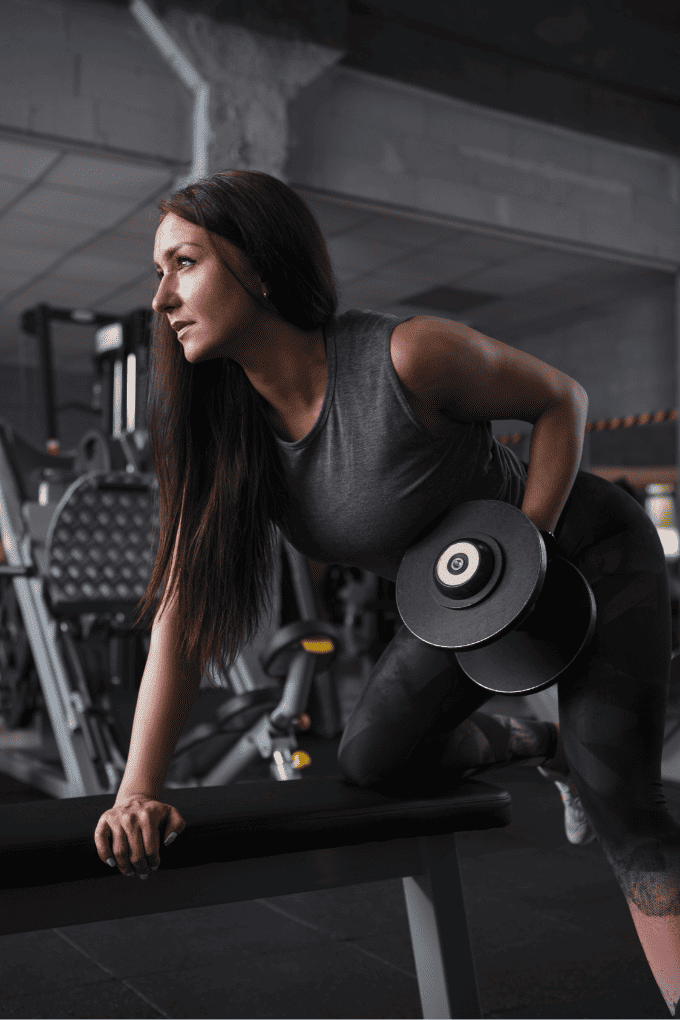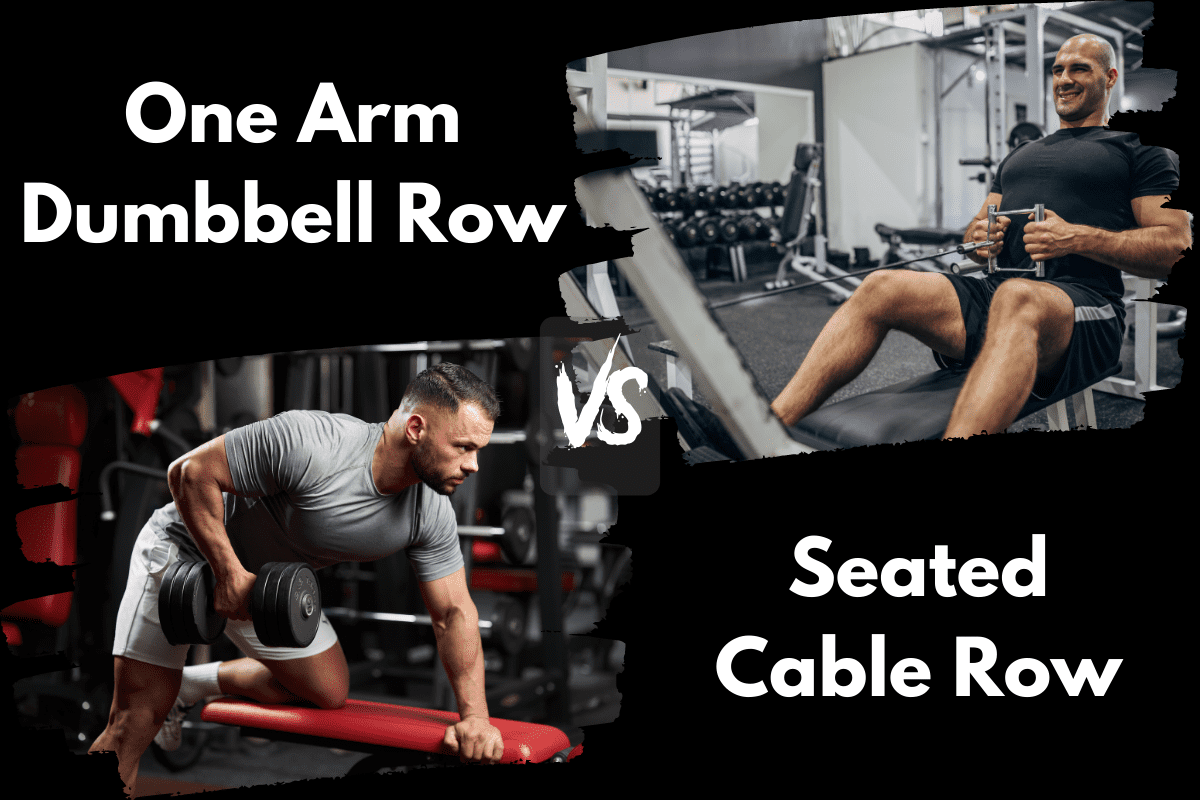Dumbbell One Arm Row vs Seated Cable Row (Is One Better?)
Dumbbell One Arm Rows and Seated Cable Rows are both excellent exercises for strengthening the upper back and developing muscle mass.
However, they differ in their setup and the equipment needed to be able to do each one.
And, even though both exercises target basically the same muscle groups, is one exercise better than the other? Should you be sticking to one of these back exercises and kicking the other to the curb?
In this article, I’m going to go over how to do each exercise and then compare how they stack up against one another depending on individual training goals and preferences.
One Arm Dumbbell Row

Equipment Needed
- Dumbbells
- Bench (optional)
A bench is helpful, but not totally necessary. Bracing one arm against the rack or even on your leg can work as well.
Muscles Worked
- Latissimus Dorsi
- Teres Major
- Posterior Deltoids
- Trapezius and Rhomboids (at contraction)
- Secondarily: Biceps (Biceps Brachii, Brachialis, Brachioradialis)
Step-by-Step Instructions
- Grab a dumbbell and a bench*.
- Place the dumbbell next to the bench and set yourself up.
- If rowing with the right arm, place the left knee and left hand on the bench. Keep the right foot flat on the ground.
- Make sure the back is flat (neutral) to slightly arched.
- Brace the core and pick the dumbbell up.
- Row the dumbbell up, keeping the elbow close to the body as the dumbbell raises.
- Squeeze the back at the top of the rep and then lower the dumbbell down until the arm is fully extended.
- Repeat for the designated number of reps and then switch sides.

*One Arm Rows do not have to be done with one knee on a bench. You can keep both feet flat on the ground and lean forward and brace yourself with your off-hand on something sturdy. You can even lean your off forearm on your leg for support if necessary.
Coaching Points
The most common mistake I see athletes make when doing One Arm Rows is not maintaining a flat back.
The back should stay engaged and slightly arched – similar to the starting position of a Power Clean. Do not let the back round as this can cause unnecessary stress on the spine.
Also, do not twist and turn while rowing. You’re not starting a lawn mower. If you need to use your whole body to twist and rock the weight up then the dumbbell is too heavy. Lower the weight and maintain proper form.
Finally, make sure to give yourself enough room to ‘spread out’ and get into a good position.
Often times I see athletes place their off-hand too close to their knee on the bench and/or place their grounded foot too close to the bench. This leads to them being too cramped, making it difficult to achieve proper positioning.
Looking for additional alternatives for One Arm Dumbbell Rows? Here are 10 of my favorite One Arm Row alternatives.
Benefits
Some of the benefits of One Arm Dumbbell Rows include:
- Increased upper body strength: The One Arm Dumbbell Row targets multiple muscle groups in your upper body, including your lats, biceps, and shoulders. As you progress with the exercise, you’ll be able to lift heavier weights, which can help to increase your overall upper body strength.
- Improved stability and coordination: The Dumbbell One Arm Row requires balance and coordination, as you need to maintain control of the dumbbell with one hand while performing the exercise. This can help to improve your overall stability and coordination.
- Increased muscle mass: By consistently performing One Arm Rows, you can build strength and size in your back, shoulders, and arms, which can contribute to an overall increase in muscle mass.
- Improved posture: By strengthening your back muscles, the One Arm Dumbbell Row can help to improve your posture and reduce the risk of developing poor posture-related issues such as rounded shoulders or a hunched back.

Tired of coming up with your own workouts? But don’t want to pay an arm and a leg?
I post workouts 5 days a week right here. (Did I mention they’re free?)
Seated Cable Rows

Equipment Needed
- Cable Pulley Machine
How To
- Begin by setting up a cable machine with the desired weight. Adjust the seat of the machine so that it is at a comfortable height for you to sit on.
- Sit on the bench and plant your feet firmly on the ground (or foot plate). Grasp the handle attached to the cable with an overhand grip, making sure that your arms are extended straight in front of you.
- Engage your back muscles and pull the handle towards your body, bringing your elbows back as far as you can. Keep your chest up and your back straight throughout the movement.
- Hold the contracted position for a moment, then slowly return to the starting position.
- Repeat for the desired number of reps. Make sure to breathe evenly and keep good form throughout the exercise.
- When you are finished, carefully release the weight back onto the stack and return the handle to its starting position*.
Coaching Points
*Don’t be the person that just lets go of the handle at the end of your set and allows the weight stack to just come crashing down. It just tears up the machine.
Keep your core braced and maintain a static upright posture. Don’t confuse Seated Cable Row with a rowing machine. You shouldn’t be rocking back and forth through the movement.
One Arm Dumbbell Row vs Cable Row: Which is Better?
Now, let’s do a side-by-side comparison of these two rowing exercises to see if one is better than the other for a couple of common lifting goals.
Better For Developing Strength and Hypertrophy: Toss Up
My personal preferences lean towards saying One Arm Rows are better, but I can’t say with confidence that that is actually true.
I will always prefer free weight exercises over machines because of the added benefit of the body having to stabilize and control the weight through its range of motion.
However, if we’re purely talking strength and hypertrophy I believe the Seated Cable Row can do just as good of a job as One Arm Rows. This is assuming, of course, that the machine being used can go heavy enough to continue to challenge the lifter through six to twelve reps.
Pro Tip: If you’re “outgrowing” your cable row machine, try switching to a single arm attachment and do a single-arm Cable Row.
Honestly, both exercises are great options for building strength and size.
Ultimately, the biggest decider might come down to what equipment you have access to. And, if you have both dumbbells and a cable machine, then why not incorporate both exercises into your training program?
Better For Beginners: Seated Cable Row

Let me start by saying I think both exercises are relatively beginner-friendly. Both movements are rather easy to learn and execute.
I give the slight edge to Seated Cable Row because they are probably a bit easier to learn than One Arm Rows. This is because the starting position for One Arm Rows is slightly more complex (proper back position, feet placement, etc).
Also, typically most machines are less intimidating to start working on than dumbbells for true beginners.
RELATED –> 10 Seated Cable Row Alternatives for Building Mass
For these reasons I give a slight edge here to Seated Cable Rows, although I think both exercises can be utilized early on in a beginner’s lifting journey.

Need a Training Program?
Coach Horton has 20 years of experience training elite level athletes at schools like the University of Tennessee and Georgia Tech. He has also written plenty of programs for other coaches and friends and family.
So, whether you need a program to improve your performance in your sport or you just want to look good at the beach, there is a program designed just for you.
Final Thoughts
I’ve just spent an entire article comparing which is better – One Arm Dumbbell Rows or Seated Cable Rows.
However, the truth is, there is no reason you shouldn’t have both exercises in your strength training program.
Both are excellent exercises for building upper-body strength and hypertrophy. Incorporating both into your training program can also add much-needed variety and keep your plan from getting stale.
So, my suggestion would be instead of trying to decide between the two exercises, figure out how you can utilize both Dumbbell One Arm Rows and Seated Cable Rows in your training plan.
More Links and Info
Check out how One Arm Rows stack up against some other popular back exercises:

